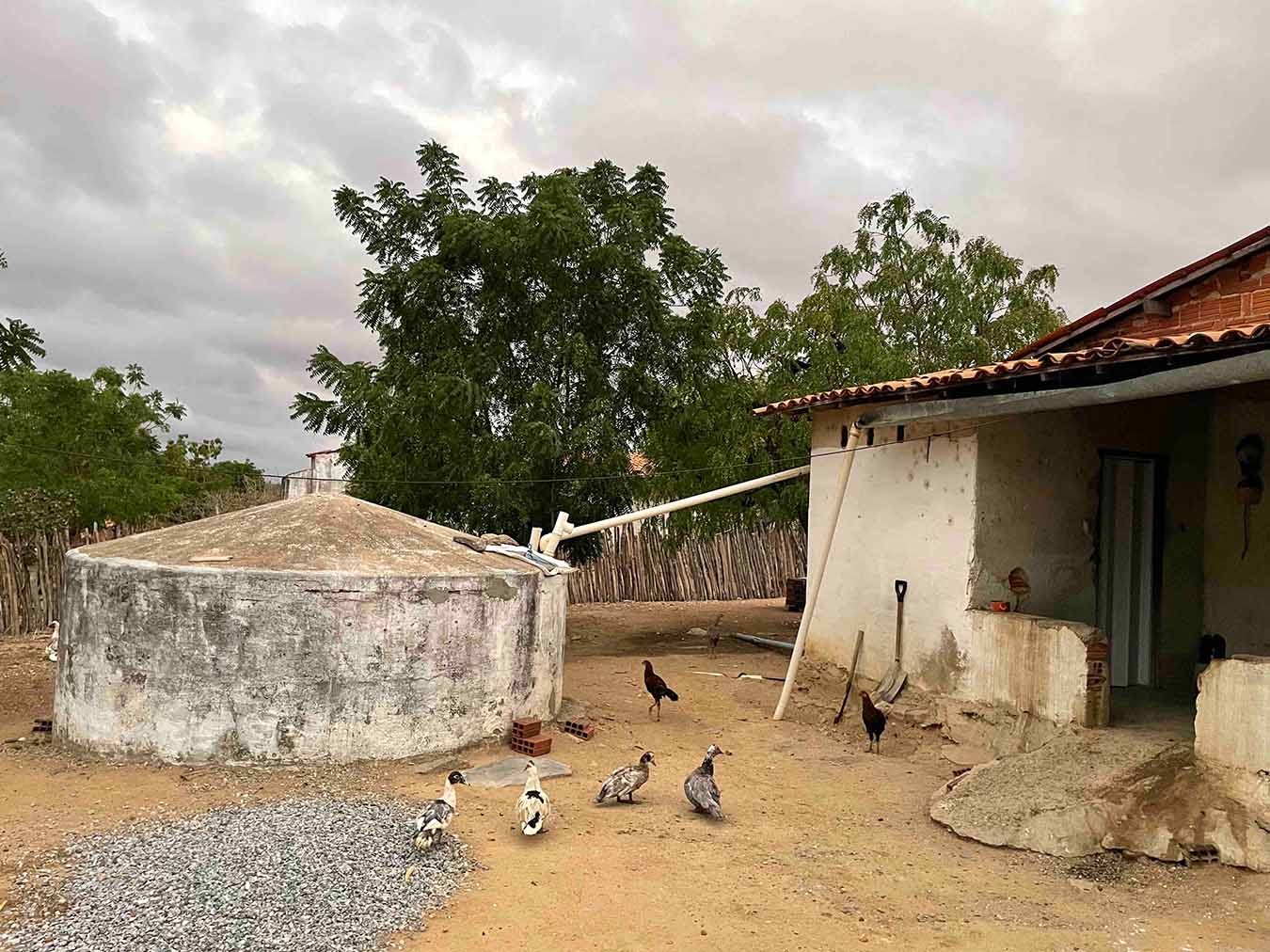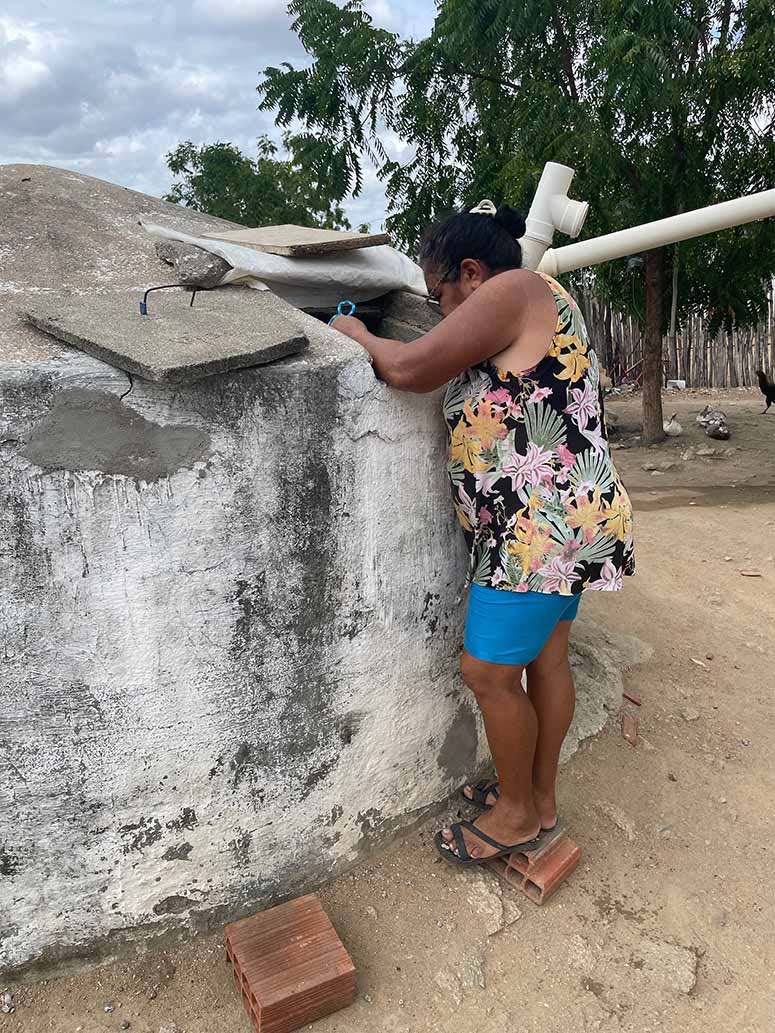The following monologue was originally written in Portuguese for the ongoing theatrical project Dramaturgias da água e da seca (Water and Drought Dramaturgies), developed by Pavilhão da Magnólia, a professional theatre group from Fortaleza, Ceará, Northeast Brazil. Based on 24 months of fieldwork in Quixeramobim, Ceará, the monologue explores the dynamics of human-water relations in the semi-arid region of Northeast Brazil from the perspective of a social technology[1] that has transformed yearlong access to potable water in the region: the cement, rain-harvesting cistern.

In the semi-arid region of Northeast Brazil, cisterns are used to collect rainfall to provide a source of potable water all-year long. (Photo credit: Seigerman)
The scene begins in silent darkness. From the silence comes the faint sound of rain falling on a clay rooftop. As the intensity of the rain increases, the backdrop becomes illuminated to represent the falling rain and the shadow of a rain-harvesting cistern becomes visible. A dull blue light illuminates the ground, making the outline of a woman sitting on the ground perceptible. The woman is surrounded by broken pieces of cement (dimensions: thickness 3-4 cm, maximum width 40 cm, maximum height 50 cm).[2] Although the pieces of cement are painted white, many are cracked or dirty. The woman wears a worn-out white nightgown and thoughtfully touches the pieces of cement that surround her, deep in reminiscence.
MADAM CISTERN: It’s been a long time since someone has fetched water from me. I’m old now, dried up… it rained a lot this winter,[3] but I am no longer able to hold on to the rain that falls. My time has come to an end…
The lighting becomes warmer (blue tones to pinks) as MADAM CISTERN continues.
MADAM CISTERN: But I remember the good times, when I was young and beautiful. I was white, so white, and every year before the winter came, my family covered me with another coat of limestone so that I would be even more beautiful.
MADAM CISTERN lifts herself from the ground gracefully, as she removes the worn nightgown to reveal a stunning white dress.
MADAM CISTERN: My first year of life was 2003. Soon after, in February 2004, I bled, [4] I overflowed for the first time. It was wonderful. Me, with a volume of sixteen thousand liters, filled to the brim. The rain and I—we were my family’s source of joy. It was a happy time.
They say that the government brought me here, but it was the masses. My family would talk about asa, the wing, and at first, I imagined a beautiful bird carrying me here. Later, I came to understand that they were not talking about the wing of a bird, but rather ASA, a collective of civil societal organizations. Articulação no Semiárido Brasileiro.[5] Dialogue in the Brazilian Semi-Arid Region. She brought me here to help the poor who live in the rural hinterlands, where money may be scant, but where there is not a dearth of either faith or hardworking people.
I was born and grew up in a hole in the ground, dug by hand by my family and our neighbors. I can still remember the pieces of concrete drying in the sun before they were placed on my frame made of wire and sweat. It took two days to build me, two days in the hot sun at the end of the winter in 2003.
The first water I tasted was from a water truck, but it was good. My family drank it. I was filled up halfway by the water truck, which I hoped was enough to survive my first summer and to not dry up before the rains arrived. Oh, the sun was hot that summer. Two or three times a week, the woman would get water from me. She used a special bucket, which never touched the ground, to fetch my water. And each time, I was left with just a bit less water. By the end of the summer, I was drying up and the worry that I would dry up completely crept up. But thank God, it rained, and it rained good in 2004. I understood for the first time what it was like to feel joy. There was an abundance of water and of elation.
The lighting becomes harsher.
MADAM CISTERN: The worst year? It was 2015 or 2016… what a difficult time! At first, when the drought came and the reservoirs dried up, I still had water. Not a lot but still some, enough to drink and maybe cook um baiãozinho.[6] Rice and beans cooked together to conserve the little water we had. I would hear the woman talking to her husband that there were too many people in line at the cacimba, the shallow well the community had dug by hand in the dried reservoir. The line was never-ending but soon the cacimba would dry out. But the cacimba continued to recharge, thank God… until the day that it too dried up and the community had to dig a new one… and later, another… and another… and another.
And when the rain still did not come, the water trucks began to arrive. Our other salvation. I was thirsty and craved the sweet water that fell from the sky. However, I only had the water-truck water to drink. It wasn’t bad, but it was not good either. And the hose was pure torment. O pipeiro, the water-truck delivery man, didn’t show me the least bit of care. He wasn’t like the woman and her husband when it was his turn to fetch water. They always opened me with such care, such love. Not o pipeiro. He opened me and forced his hose into my opening violently, filling me up only halfway, if that. I knew that the rest of the water in the tank would go to other families, but even so, I was sad. I felt violated, filled with brackish water. Not even filled. My thirst continued.

A woman fetches water from her rain-fed cistern using a rope and bucket in the interior of Ceará, Northeast Brazil. (Photo credit: Seigerman)
And the woman… A sense of hopelessness poured over her when she looked into me. She would fetch my water with the same special bucket but now with a rope to reach the deepest parts of my being, to retrieve the last few drops until the water truck appeared again.
MADAM CISTERN rips her dress.
MADAM CISTERN: My biggest crack appeared around that time, when I had dried up completely and this, in the middle of winter. I felt the crack develop. I initially noticed a slight weakness, which I attributed to my thirst. I soon realized that I was cracking from within, while my lime-coated exterior began to peal. A terrible sorrow overcame me and my family when the crack became visible from the outside. They saw me as I was: dried out and cracked. They didn’t have the money to fix me right away, and I became despondent. I was dry… broken… useless. Me, who was to ensure water for our home, bringing only despair.
MADAM CISTERN begins to mend the rip in her dress, as the faint sound of rain begins. She picks up a glass of water from below one of the broken pieces of concrete on the ground.
MADAM CISTERN: Thank God we survived those years. The rain returned, and I tasted its sweetness once again. She looks down at the partially mended rip in her dress. But I was still cracked and unable to store water from my waist up. My thirst remained unquenched. My family tried to patch me up various times, using glue and cement, but I continued to leak. Me, with my scar from the drought, could no longer provide my family with the security I once gave them. Never again did I experience the pleasure of being full and overflowing with that sweet, sweet water that falls from the skies. I don’t know if I will ever feel like that again. My family still fetches water from me, and they are happy during the winter. Yet, each year, as November approaches, so does their sense of worry. Will she last this year? What if the rains do not come?
MADAM CISTERN dresses in the nightgown once again and returns to the ground, where she was sitting at the beginning of the scene.
MADAM CISTERN: Over the years, the rains came and did not come. I savored the sweet rainwater and endured os pipeiros and the water they brought in their water trucks. And now, my family fetches water from their neighbors, while I remain dry and cracked. I hear the woman say that I am beyond repair, and, with hope in her voice, she talks about how one day, they will rebuild me. I pray for the day when I will once again secure water for my family and bring them pride and joy.
Darkness.
Notes
[1] Social technology (tecnologia social) is defined as a “set of techniques, transformative methodologies, developed and/or applied in interaction with local groups of people and appropriated by them, which represent solutions for social inclusion and improvement of living conditions” (ITS Brasil, “Tecnologia Social,” ITS Brasil, Accessed 22 July 2023). According to ITS Brasil, social technologies have four dimensions: social relevancy; knowledge, science, technology, and innovation; education; and participation, citizenship, and democracy.
[2] The dimensions are of a standard block of cement used to construct a 16,000 L rain harvesting cistern as part of the Brazilian Federal Government program, Programa Nacional de Apoio à Captação de Água de Chuva e Outras Tecnologias Sociais de Acesso à Água (National Program to Support the Harvesting of Rainwater and Other Social Technologies for Water Access) (Programa Cisternas, “Modelo da Tecnologia Social de Acesso À Água Nº 01: Cisternas De Placas de 16 Mil Litros,” Ministério do Desenvolvimento e Assistência Social, Família e Combate à Fome, Accessed 22 July 2023).
[3] In Ceará, Brazil, the term “winter” (inverno) refers to the rainy season and the term “summer” (verão) is often used to refer to the dry season. In the interior, these popular terms are most often used to describe rainfall patterns of a given year and often do not match up perfectly with the technical definitions used by the State Government of the pre-rainy season (December – January), rainy season (February – May), and dry season (June – November).
[4] The term sangrar (to bleed) is a popular term used in Ceará to describe the act of overflowing of a water source, such as a reservoir or cistern.
[5] Articulação no Semiárido Brasileiro (Dialogue in the Brazilian Semi-Arid Region) is a network of civil society organizations, including non-government organizations, social movements, rural workers unions, and farmers associations, that “defends, propagates, and puts into practice, through public policies, the political project of ‘Living with the semi-arid region’” (ASA, “Sobre Nós – História,” Accessed 22 July 2023). In 1999, ASA developed the Program One Million Cisterns (Programa Um Milhão de Cisternas, P1MC) with the goal of improving access to potable water in the semi-arid region of Brazil through the building of household rain-harvesting cisterns. The Program began to receive federal funding in 2003, during Lula’s mandate as president of Brazil. Between 2003 and 2018, 929 thousand drinking-water cisterns were constructed in the semi-arid region of Brazil, while during the presidential mandate of Bolsonaro (January 1, 2019 – December 31, 2022), about 42 thousand cisterns were constructed (Madson Euler, “Governo Bolsonaro construiu pouco mais de 42 mil cisternas,” 31 January 2023, Empresa Brasil de Comunicação, Accessed 22 July 2023).
[6] Baião de dois (diminutive: baiãozinho) is a typical dish from the interior of Northeast Brazil made of rice and beans cooked together.
